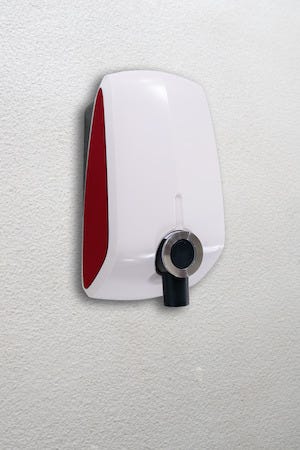Focus on charging plugs, charging stations, wall boxes, and inductive charging systems, with transfer of know-how from E&E and automotive applications.
July 24, 2020

In addition to new applications in the powertrain of electric vehicles, the specialty chemicals company Lanxess sees great potential for engineering thermoplastics in the charging infrastructure for electric mobility. Requirements regarding the various components are derived primarily from the electrical and electronics (E&E) industry and the automotive industry. “Both industries have for decades been a core business for our polyamides and polyesters. This is why we can already offer custom materials that meet the most important standards and specifications of the international E&E and automotive industries and are ideal for use in charging infrastructure,” says Sarah Luers, project manager in E&E application development in the Lanxess High Performance Materials (HPM) business unit.
|
Polyamide compound scores high points for charging infrastructure. Image courtesy Lanxess. |
Durethan polyamide (PA) and Pocan polybutylene terephthalate (PBT) are mainly used for components of charging plugs and sockets, charging stations and wallboxes – in garages and carports, for example – as well as for components in inductive, wireless charging systems for high-voltage batteries. Even though the level of standardization in the field of electric mobility is currently still in progress in many areas, polyamides and polyesters already offer a wide range of possibilities for applications in the area of battery charging with direct or alternating current.
Unreinforced materials are mainly used for charging plugs because they offer a high level of dimensional stability and surface quality, are impact resistant, and thus mechanically robust, and are also available as flame-retardant compounds whenever they come into contact with live electronic parts. Says Luers: “One example is the halogen-free flame-retardant PA 6 Durethan B30SFN30. In flammability tests conducted in accordance with the US standard UL 94 (Underwriters Laboratories Inc.), it achieves the top classification of V-0 with a test body thickness of 0.75 millimeters.” The polyamide 6 Durethan B30S, however, is ideal for thin-walled components such as plug handles, which do not necessarily have to be flame-retardant.
Given the ever-higher charging voltages and currents, heat-conductive thermoplastics for removing the heat that is generated are also becoming increasingly important. Mineral-based Durethan BTC965FM30 and BTC77ZH3.0EF PA 6 compounds, which have a high filler content, are ideal for components in the vicinity of charging plugs. The former is halogen-free flame-retardant and achieves V-0 classification (0.75 millimeters) in the UL 94 test. Durethan BTC77ZH3.0EF contains a special mineral filling, with which it is possible to achieve a near-isotropic thermal conductivity of up to 1.8 watts per meter and Kelvin. Despite the high filler content, the material displays excellent elongation and processing characteristics.
Charging sockets usually require a combination of excellent fire resistance, mechanical strength, and good expansion characteristics. “These requirements are met by the halogen-free, flame-retardant and glass-fiber-reinforced grade Durethan BKV30FN04 PA 6, for example, which is also listed by the UL with V-0 classification,” says Luers.
Potential new applications for charging wallboxes include covers and structural components. As visible parts, covers have to be not only easily paintable and weathering- as well as UV-resistant, but also have a low tendency to warp. This requirements profile is met by Pocan C1203, for example, an unreinforced blend of polycarbonate and polybutylene terephthalate (PBT).
Typical requirements for structural components such as mounting systems for wallboxes include high flame retardancy, weathering resistance, and creep resistance paired with high toughness and a low tendency to warp. “The material of choice here is the highly reinforced, and thus extremely strong and rigid, Durethan BKV45FN04,” says Luers. The halogen-free flame-retardant PA 6 displays a high of 600 V (CTI A) and achieves UL 94 V-0 classification at 0.4 millimeters.
Another current development trend is inductive and wireless charging of vehicle batteries. The flat floor and vehicle pads that are required here and accommodate – among other things – the inductive charging coils have to be constructed from materials that are not only fire-resistant and mechanically strong, but also have a low tendency to warp and exhibit high dielectric strength. The materials also have to be light- and weathering-resistant, with their properties remaining highly stable across a temperature range of -45 to +125 °C. One material that can be used for floor plates is the glass-fiber- and glass-ball-reinforced polyamide 6 Durethan BG30XFN01. It displays excellent flow properties and is also extremely strong and resistant to warpage. It passes the UL 94 test with V-0 with a test body thickness of 0.75 millimeters. It also has a UL f1 listing for use in outdoor applications exposed to UV and water.
HPM supports customers along the entire development chain of components used in the charging infrastructure for electric mobility. Services include developing application specific materials and optimizing processing. The package also includes engineering services during component design such as CAE simulations, mold flow calculations, and various finished part testing. “We also perform standard-compliant tests for UV resistance and fire behavior such as glowing wire tests in accordance with IEC 60695-2-13,” says Luers. The scope of services also encompasses electrical tests such as for dielectric strength in accordance with IEC 60243-1.
About the Author(s)
You May Also Like





